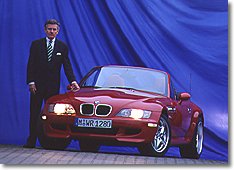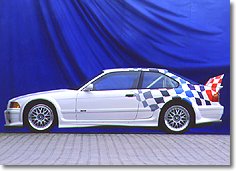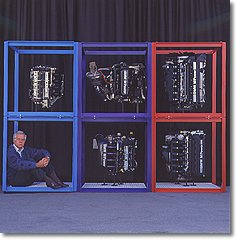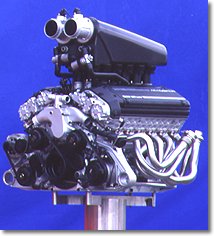 |
| THE BMW M-COMPANY What would be the Bayerische Motor Werke without its "M", without the 13th letter in the alphabet which stands as a monumental symbol for "BMW Motors". This letter is a clear indication that the Bavarians have always placed special value on their motors - and their customers thank them with a growing flood of orders and a brand loyalty which makes the company the envy of its competitors. So it comes as no surprise that this letter has come to have a very special meaning at the BMW headquarters on the Peutelring in Munich - and that a very special company has developed of the last 24 years: The "BMW Motorsport GmbH", which - originally planned to be the works racing department - has adapted its tasks and its name to keep abreast with the times. Although "BMW GmbH - Gesellschaft für individuelle Automobile" is no longer responsible for motor racing today, its sprit and dynamism is still bound to its glorious past which began with a fanfare its very first appearance. Dutch driver Toine Hezematts won at the Nürburgring with the debut of the 3.0 CSL works coupé. A great start which was to be followed by countless victories with touring cars, Formula 2 and Formula-One world championships. And also a start from which a very specific type of BMW vehicle would emerge: The BMW M series. Today, whenever automobile connoisseurs see an M3 or M5, they know: The "M" means that a very special motor has been built into the car. Adolf P. Prommesberger, head of the BMW M-GmbH and a M-Roadster Z3 Originally founded as the works racing team department, today the "M GmbH" offers the company the opportunity to offer automobiles which are treasured by a very small circle of connoisseurs. For Adolf P. Prommersberger, Chairman of the Board of Management, these - partly hand-made - automobiles are the company's most prized products. Strangely enough, the car building history of this exclusive subsidiary began under quite different circumstances. The M1 - which had in the meantime become a legend - was originally designed as a homogenised series car in order to successfully participate in motor racing. The regulations during the mid-seventies stipulated a series of at least 400 cars to be able to participate in GT class races. Thus, in the late summer of 1976, Motorsport GmbH produced the first M1. Nobody knew at that time that the regulations were to be subsequently changed and that the M1 would never take part in the races it was originally intended for. The result was a dream of a mid-engined car built with solid German workmanship. As the press said at the time: "...a racing car designed for road use, not for the masses but for the a discerning few." Production of the M1 was stopped after exactly 456 cars had been constructed. At the same time, this was the signal for new perspectives. The formidable engine of the M1 could now be integrated into the top-of-the-range BMW models and Motorsport GmbH grew to be a top producer of high-class road cars which combined the power of high-performance racing cars with the reliability of series models. Paul Rosch, father of this engine and BMW's motor guru said: "Suddenly we were given the opportunity to present a select circle of potential buyers who were interested in something really special the chance to buy a toned-down racing engine for daily use." He, like all other insiders praised the design of this six-in-line engine with it's overhead camshafts which originally produced 277 HP and, through the development of electronic technology, grew to 340 HP for the M5 engine. Times change and the wishes of the car-buying public too. "Following the success of the M635 CSi engine - by now built into 5 915 cars - it was almost inevitable that BMW turned its thoughts towards a high-performance limousine - a wolf in sheep's clothing perhaps - suitable for more introverted drivers. Although we had already had a 5 series model offering a top speed of 220 kph in our program with the M 535i in 1980, the M5 - introduced in 1984 - was the first real kick." reminisces Prommesberger. "With 285 HP and a top speed of 245 kph, the M5 showed the direction in which we had to move." Although priced at 80 750 DM, this limousine achieved a sales figure of 2 180, proving that there were enough buyers out there who were prepared to pay more for something really special. The mystery behind the legendary reputation of the M automobiles surely lies in the mixture of racing experience and everyday practice - and clever management by combining the requirements of motor racing with the wishes of potential purchasers hungry for a high-power vehicle. The fact that the team in the subsidiary's headquarters in the Preußenstrasse had already recognized the potential of a new circle of potential purchasers looking for more performance and individuality, could only be an advantage for the reputation and standing of the team inside and outside of the parent company. "For us, the M vehicles have always been the highest form of innovation". For Adolf P. Prommesberger and his 387 strong team, these creations on four wheels are the crowning glory of the BMW philosophy: "To enhance the much lauded joy of driving on the basis of a very good series model - a fascinating task." The M GmbH had always prized the direct contact the racing division. "After all, both the M1 and the M3 were at first spin-off products from our racing activities - the development of the cars were a result of our material-killing activities on the racing scene." The managing director like to point out why the Motorsport GmbH was able to go its own way so quickly: "The re is only one way to go in motor racing - towards victory. To achieve this target, one first has to develop the strategy and concept, and then implement them. The leadership concepts and management strategies so often quoted today have been determining factors in motor racing for 100 years: zero error programs, continuous improvements and customer orientation. Only with engineers who are able to cope with the daily process of optimization so necessary in the racing business, can the high expectations be fulfilled and solutions found in the shortest possible time." The success of the M5 demonstrated that there was an interesting pool of potential customers for such a top-of-the-line product. Viewed thus, the development of the M5 was a logical one. After all, BMW had already had a 4 cylinder motor which, in all performance classifications - up to 1300 HP - had been available to the Brabham team and Nelson Piquet as training motor for years and which catapulted the Brazilian to the Formula-One world title. The GT version of the famous BMW M3 Reduced to a capacity of 2.3 litres and with a stable performance of 200 HP, the M3 - introduced in 1986 - quickly became the most sporting car of its day, not only selling 17 704 models but also giving BMW its perfect sporting record. This was ensured through the introduction of the two-door limousine which played a decisive role in the winning of the impressive number of 288 national championships which are still part of the company's legendary reputation. In 1988, the first M3 convertible was introduced - the first of all the M types - which found 786 purchasers. However, the developers already had their eyes on the next generation which celebrated its world premiere in October 1990. Although the "old" M3 had been integrated into the existing series, the next M3 generation was planned as a new concept right from the word go. Here too, the sporting subsidiary demonstrated the close symbiosis between motor racing and sporting cars because the "new" M3 was introduced first as a coupé - a condition that the racing division staff had insisted upon.The reason for this is easy to understand: the new coupé offered < flatter and more aerodynamic body which allowed much higher speeds. Thus, the racing models could utilize the available HP to achieve better lap times. However, the revolution itself was carried out under the bonnet of the elegant two-door model. This now had a 286 PS strong three-litre six cylinder engine which replaced the old four cylinder engine (the last evolution stage producing 238 HP from a 2.5 litre engine). This engine became the masterpiece of "M GmbH" - as the company was re-christened in September 1993: "This car means that we have solved all conflicts affecting sports cars" was the happy comment from Dr. Wolfgang Reitzle, the board member responsible for research, development and purchasing at BMW on the occasion of the presentation: "Bridging the gap between High performance and fascination, economical feasibility and everyday use." And the M3 did indeed set new standards in the sports car sector. Now equipped with a 3.2 litre engine producing 321 HP (100 HP per litre) the car was able to accelerate to 100 kph in only 5.5 seconds with the floating compound braking system reducing to the speed to zero in only 2.8 seconds. The torque of 350 Nm which was fully available at 3 250/min allowed easy driving in city traffic, whereas the maximum speed of 250 kph (this maximum speed was agreed between BMW and all other German car manufacturers) could be achieved in sixth gear with power to spare. These figures - which equal anything super sports cars can produce - were achieved with fuel consumption values which, for sporting drivers, can only be attained above the ten litre threshold. Otto Pukl, head of the engine development department of the M-GmbH with some "M-engines" No wonder then that the entire trade press heaped acclaim on this new design and that shortly afterwards M GmbH also introduced the four door limousine and spectacularly beautiful convertible to the market. In the meantime, motor sport had become so expensive that the parent company had to take over the costs - a company such as "BMW M GmbH" with a turnover of 300 million marks could no longer carry them. In addition, a new type of car buyer had emerged over the years: the individualist who insisted that his car was different from the masses. Thus, the theme of "individualism" became more and more important. "And as far as we are concerned, this is the highest form of customer orientation - where else can a customer have his own personal car built at the works. A car which expresses the customer's wishes from the engine through to the chassis and suspension, interior and exterior?" At the same time, the company extended its efforts in the sectors of system technology and service - the system technology being developed for both BMW and other companies. One wonderful example of this is the legendary M8 which was a perfect example of how a GT car could be presented as a no-compromise, high-performance coupé. Or another example: the "S70/2" twelve cylinder engine of the McLaren F1 which, with a 6.1 litre engine, 609 HP and a top speed of 350 kph will probably remain the ultimate high-end sports car of all time. Another dream came true: The "S70/2" twelve cylinder engine of the McLaren F1 The term "service", according to Adolf P. Prommesberger is closely linked with the BMW driver training scheme. With this scheme, the company offers customers all over the world to improve their mastery over their cars with the help of BMW instructors. As all these activities were only partially connected to motor sport directly, the company was renamed "M GmbH" in 1993. Prommesberger: "Today I see our tasks broken down into four sectors: The services, already mentioned, which we have brought together under the title BMW System Technology and driver training. In addition, the parent company builds the M vehicles for us in our name - and last but not least, the individualist cars built for customers to their own personal specification." The number of cars leaving the works with the "M" symbol at the rear is astounding high - 13 000 M3 vehicles in the three variations are manufactured per year. In addition, around 25 000 cars are produced in accordance with individual customer specifications - 15 000 of these are models for customers ordering from their local dealers specifying their wishes, the other 10 000 are produced by M GmbH to suit demands from the dealers themselves. These include special series which a dealer might wish to offer, for example, in a special sales action. BMW is one of those manufacturers who have always placed importance on the special wishes of their customers and not restricted themselves to package deals. Currently, the versatile range means that out of a total production of 600 000 cars, theoretically no two cars need to be identical. However, as their are customers with extremely special wishes, M GmbH has set up a department of specialist craftsmen who build the ultimate vehicles - cars that are built entirely to customer specification and endeavour to realize every single customer request. Around 500 customers per year allow themselves this luxury, including such luminaries as Karl Lagerfeld, José Carreras or artist David Hockney who had two special dog seats installed in his 850 CSi in place of the passenger seat for his beloved dachshunds. The highest individuality in car design, however, can also mean office equipment with which frequently travelling manages no longer need to without all means communication - or the Swiss businessman that has already delivered his 850i coupé to the Munich works in order that the colour and interior be adapted to his changing personal taste. "Actually, M GmbH is the first "virtual" company in the automobile industry" contemplated its managing director, "because we break down all barriers and allow our customers to realize their dreams." And the fact that in addition to the almost boundless freedom this implies, it is also backed by the advantages of a large series product is an added attraction. "Perfect quality, absolute reliability and suitability foe everyday use are our watchwords. And this mixture is the secret." |
 |
 |
 |
 |